Home » Rocks » Metamorphic Rocks » Skarn
Skarn
A metamorphic rock that has been altered by hot, chemically active fluids.
Article by: Hobart M. King, PhD

Skarn: A specimen of skarn composed mainly of garnet, pyroxene, carbonate, and quartz. This specimen is approximately three inches across.
What is Skarn?
Skarn is a metamorphic rock that has been chemically and mineralogically altered by metasomatism. Metasomatism is the alteration of rocks by hot, chemically-active fluids that flow or diffuse through the rocks and cause recrystallization and compositional change.
Skarn commonly forms around the edges of a magma body that intrudes a nearby rock mass. Rocks formed or altered by the interaction of magma, country rock, reactive fluids, and heat are known as skarn. Other environments of metasomatic activity are also known to produce skarn.
|
|

Skarn in Carbonates: This diagram illustrates a cross section through a porphyry molybdenum deposit and its associated skarns. The skarns have formed within a carbonate bed near where it had been penetrated by igneous intrusions. Molybdenite is the most important ore mineral of molybdenum. Illustration by the United States Geological Survey, modified after R.H. Sillitoe. [1] [2]
An Example of Skarn Formation
Most skarns form when carbonate rocks such as limestone, dolostone, or marble are intruded by a magma body and altered by contact metamorphism and metasomatism. At the time of intrusion, the heat of contact metamorphism is the primary agent of change.
Then, as the magma cools, it releases hot, acidic, silicate-rich fluids. Some magmas contain up to several percent dissolved water on the basis of weight, but because of the specific gravity difference between water and magma, the volume percent of dissolved water is at least twice the weight percent.
When this water is expelled from the magma, it is a solvent that has the ability to carry heat and chemically-active solutes into the country rock.
Water leaving the magma moves through the surrounding country rock by flowing or diffusing through pore spaces, fractures, and even the mineral grains that make up the rock. As it invades carbonate rock, the hot, acidic, metal-laden water dissolves, replaces, recrystallizes, and alters minerals in the carbonate rock.
These acidic waters are superheated and supersaturated with dissolved metal ions, especially calcium and silicon. As the acidic water moves through the carbonate rocks, its temperature falls and its acidity is neutralized. As this occurs, large amounts of calc-silicate minerals begin to precipitate in the carbonate country rock and change its composition.
Many different types of rock can be transformed into skarn by metasomatism. The original rock that is altered is known as the "protolith". Although carbonate rock is the most common protolith, many skarns have formed in granite, basalt, conglomerate, tuff, shale, and other types of rock.
Skarn as a Complex Rock Mass
Skarns can form on both sides of the boundary between a magma body and its surrounding rock mass. Those formed on the igneous side of the contact are known as endoskarns. Those formed on the country-rock side of the contact are known as exoskarns.
Exoskarns form when the original chemistry of a rock mass is altered - as hot fluids of incompatible chemistry flow or diffuse through the rock. The intensity of alteration and the types of minerals formed can change with distance from the magma body. These mineral variations across the rock mass develop in response to gradients in temperature and chemistry over geography and time.
Other Skarn Environments
In the example described above, skarn formed in a carbonate rock unit adjacent to a magma intrusion. There are numerous other geological situations where skarn can be formed. These include:
- skarn associated with seafloor hydrothermal systems;
- skarn formation along faults and shear zones;
- skarn forming at depth in areas of regional metamorphism;
- skarn above subduction zones;
- and many other geological situations.
- water from magma;
- shallow groundwater;
- seawater; or
- deep brines.
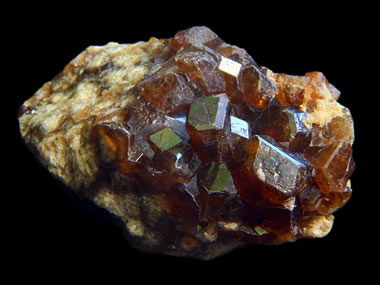
Andradite Garnet from Skarn: A specimen of andradite garnet from skarn, collected near Dalnegorsk, Russia. Creative Commons photo by Lech Darski.
Minerals Found in Skarn
Skarns often contain a diverse assemblage of metamorphic minerals. The mineral assemblage in a skarn is determined by the lithology of the invaded rock, the chemistry of the invading liquid, and the temperature of the rock environment.
Metamorphic minerals that characterize the skarn environment include a wide range of calc-silicates, many types of garnet, and a range of pyroxenes and amphiboles. Occasionally, valuable metallic mineral ores occur in skarn. Some of the world’s best copper, gold, lead, molybdenum, tin, tungsten, and zinc deposits have been in skarn.
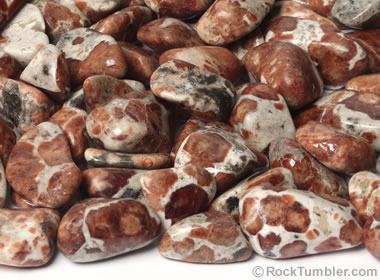
Garnet Crystals in Skarn: Tumbled stones produced from pieces of skarn that have been processed in a rock tumbler. Stones average about one inch across. Photo by RockTumbler.com.
| Skarn Information |
|
[1] Arc-Related Porphyry Molybdenum Deposit Model, by R.D. Taylor, J.M. Hammarstrom, N.M. Piatak, and R.R. Seal, II, Chapter D of Mineral Deposit Model for Resource Assessment, United States Geological Survey, Scientific Investigations Report 2010-5070-D, 64 pages, 2012.
[2] Porphyry Copper Deposits, by R.H. Sillitoe, Economic Geology, volume 105, pages 3-41, 2010. [3] Skarn Deposits - Our Largest Source of Tungsten: by Kylie Williams, article on the Geology for Investors website, last accessed March 2022. [4] Demantoid and Topazolite from Antetezambato, Northern Madagascar: by Federico Pezzotta, Ilaria Adamo, and Valeria Diella; Gems & Gemology, Spring 2011, Volume 47, Number 1, pages 2 to 14. [5] Sapphires from the Andranondambo Region, Madagascar: by Dietmar Schwarz, Eckehard J. Petsch, and Jan Kanis; Gems & Gemology, Volume 32, Number 2, pages 80 to 99. [6] Yellow Scapolite from Ihosy, Madagascar: by Margherita Superchi, Federico Pezzotta, Elena Gambini, and Emanuela Castaman, Gems & Gemology, Volume 46, Number 4, pages 274 to 279. [7] Expedition Report to the Ruby Mining Sites in Northern Mozambique (Niassa and Cabo Delgado Provinces): by Vincent Pardieu, Stephane Jacquat, Jean Baptiste Senoble, Lou Pierre Bryl, Richard W. Hughes and Mark Smith; report published on the Gemological Institute of America website, last accessed March 2022. |
Gems in Skarn Deposits
A variety of gemstones have been found in skarn. Garnet, ruby, and sapphire are the gems most commonly found in skarn. Here are a few examples:
Demantoid garnet and topazolite have been mined from the Antetezambato skarns near Ambanja, northern Madagascar. [4]
Sapphires are mined from skarn in the Andranondambo Region of Madagascar. [5]
Yellow scapolite has been mined from a skarn deposit near the town of Ihosy in southern Madagascar. [6]
Rubies have been found in the skarns of northern Mozambique. [7]
Sometimes pieces of skarn are processed in a rock tumbler to produce interesting gems (see the accompanying photo).
| More Rocks |
 |
Tumbled Stones |
 |
Fossils |
 |
Geodes |
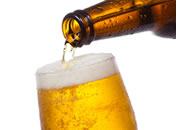 |
The Rock Used to Make Beer |
 |
Topo Maps |
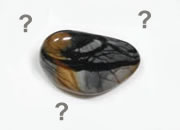 |
Difficult Rocks |
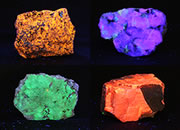 |
Fluorescent Minerals |
 |
Sliding Rocks on Racetrack Playa |

Find Other Topics on Geology.com:

|

| ||

|

| ||

|

| ||

|

|
